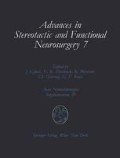Summary
To be a fully effective, a treatment against spasticity has to match as closely as possible the major pathophysiological disorders responsible for increased tone and hyperreflexia. It is possible to analyze those existing at the spinal cord level by techniques of clinical neurophysiology. Among the functional modifications, increased excitability of alpha motoneurones, reduction in presynaptic inhibition and changes in interneuronal excitability are the most clearly documented. In fact, spasticity results from a combination in various proportions of these different pathophysiological troubles. As the myorelaxants have a specific mode of action, drug selected should be me which is the more able to correct the predominant trouble; this latter can easily be known by clinical neurophysiologic analysis.
Access this chapter
Tax calculation will be finalised at checkout
Purchases are for personal use only
Preview
Unable to display preview. Download preview PDF.
References
Angel RW, Hoffmann WW (1963) The H reflex in normal, spastic and rigid subjects. Arch Neurol 8: 591–596
Baldissera F, Hultborn H, Illert M (1981) Integration in spinal neuronal system. In: Brooks VB (ed) Handbook of physiology, Sect I, The nervous system, vol II, Motor control. Am Phys, Soc, Bethesda, pp 509–595
Buller A, Dornhorst AC (1957) The reinforcement of tendon reflexes. Lancet ii: 1260 - 1262
Burke D (1985) Mechanisms underlying the tendon jerk and H- reflex. In: Delwaide PJ, Young RR (eds) Clinical neurophysiology in spasticity. Restorative neurology, vol 1. Elsevier, Amsterdam, pp 55–61
Day BL, Rothwell JC, Marsden CD (1983) Transmission in the spinal reciprocal IA inhibitory pathway preceding willed movements of the human wrist. Neurosci Lett 37: 245–250
Delwaide PJ (1971) Etude expérimentale de l’hyperréflexie tendineuse en clinique neurologique. Éditions Arscia, Bruxelles, 324 p
Delwaide PJ (1973) Human monosynaptic reflexes and presynaptic inhibition. In: Desmedt JE (ed) New developments in EMG and clinical neurophysiology. Karger, Basel, pp 508–522
Delwaide PJ (1984) Contribution of human reflex studies to the understanding and management of the pyramidal syndrome. In: Shahani B (ed) Electromyography in CNS disorders: Central EMG. Butterworths, Boston, pp 77–109
Delwaide PJ (1985) Electrophysiological testing of spastic patients: its potential usefulness and limitations. In: Delwaide PJ, Young RR (eds) Clinical neurophysiology in spasticity. Restorative neurology, vol 1. Elsevier, Amsterdam, pp 185–203
Delwaide PJ, Schoenen J, Pasqua V de (1985) Lumbosacral spinal evoked potentials in patients with multiple sclerosis. Neurol 35: 174–179
Dietrichson P (1971) The role of the fusimotor system in spasticity and parkinsonian rigidity, Oslo, pp 101
Fisher MA, Shahani BT, Young RR (1978) Assessing segmental excitability after acute rostral lesions. I. The F response. Neurology 28: 1265–1271
Gillies D, Lance JW, Neilson PD, Tassinari CA (1969) Presynaptic inhibition of the monosynaptic reflex by vibration. J Physiol (Lond) 205: 329–339
Hagbarth KE, Eklund G (1966) Motor effects of vibratory stimuli in man. In: Granit R (ed) Muscular afferents and motor control. Nobel Symposium I. Almqvist & Wiksell, 466 p
Hayat A (1979) Factorial analysis of specific parameters in spasticity. Electromyogr Clin Neurophysiol 19: 541–553
Katz R, Pierrot-Deseilligny E (1982) Recurrent inhibition of alpha-motoneurons in patients with upper motor neuron lesions. Brain 105: 103–124
Lance JW (1966) The reflex effects of muscle vibration. Proc Aust Assoc Neurol 4: 49–56
Lance JW (1980) Symposium synopsis. In: Feldman RG, Young RR, Koella WP (eds) Spasticity: Disordered motor control. Year Book, Chicago, pp 485–494
Liberson WT (1976) Averaged late reflex responses in hand muscles of spastic patients. In: International symposium on reflexes and motor disorders, Brussels, pp 118
Matthews PB, Rushworth G (1957) The selective effect of procaine on the stretch reflex and tendon jerk of soleus muscle when applied to its nerve. J Physiol (Lond) 135: 245–262
Paillard J (1955) Réflexes et régulations d’origine proprioceptive chez l’Homme. Thèse Fac. des Sciences de Paris (Série A. n 2858 ). Arnette, Paris, 293 p
Pierrot-Deseilligny E, Mazieres L (1985) Spinal mechanisms underlying spasticity. In: Delwaide PJ, Young RR (eds) Clinical neurophysiology in spasticity. Restorative neurology, vol 1. Elsevier, Amsterdam, pp 63–76
Pierrot-Deseilligny E, Bussel B, Held JP, Katz R (1976) Excitability of human motoneurones after discharges in a conditioning reflex. Electroenceph Clin Neurophysiol 40: 279–287
Rushworth G (1960) Spasticity and rigidity: an experimental study and review. J Neurol Neurosurg Psychiatry 23: 99–117
Shahani BT, Young RR (1971) Human flexor reflexes. J Neurol Neurosurg Psychiatry 34: 616–627
Tanaka R (1974) Reciprocal la inhibition during voluntary movements in man. Exp Brain Res 21: 529–540
Vallbo AB, Hagbarth KE, Torebjörk HE, Wallin BG (1979) Somatosensory, proprioceptive, and sympathetic activity in human peripheral nerves. Physiol Rev 59: 919–957
Author information
Authors and Affiliations
Editor information
Editors and Affiliations
Rights and permissions
Copyright information
© 1987 Springer-Verlag
About this paper
Cite this paper
Delwaide, P.J. (1987). Spasticity: from Pathophysiology to Therapy. In: Gybels, J., Hitchcock, E.R., Meyerson, B., Ostertag, C., Rossi, G.F. (eds) Advances in Stereotactic and Functional Neurosurgery 7. Acta Neurochirurgica Supplementum, vol 39. Springer, Vienna. https://doi.org/10.1007/978-3-7091-8909-2_24
Download citation
DOI: https://doi.org/10.1007/978-3-7091-8909-2_24
Publisher Name: Springer, Vienna
Print ISBN: 978-3-7091-8911-5
Online ISBN: 978-3-7091-8909-2
eBook Packages: Springer Book Archive

